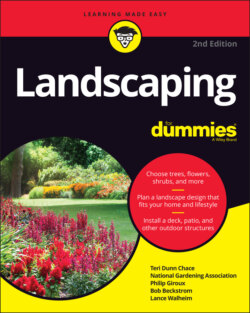Читать книгу Landscaping For Dummies - Lance Walheim - Страница 94
Grading Your Property
ОглавлениеGrading a site means leveling the soil to the desired contour — usually a flat surface, slightly sloped to allow for drainage. (Note: The land under a proposed deck site doesn’t need to be level.) Grading for lawns and planting beds may also include adding soil amendments.
In any case, we’re talking about pick-and-shovel work. For small areas, hand tools suffice. For a large patio or a complete landscaping overhaul project, rent a small tractor with a scoop loader and grading attachments.
The basic rule for grading for patios, walks, and foundation sites is the Goldilocks rule: not too much, not too little, just right. Built structures must rest on undisturbed soil, so don’t overdig. Where additional soil is required, compact it carefully to minimize settling.
When you’re grading your property, start with measuring. Don’t rely on eyeballing; always check your work with a level. For larger sites, use the following steps to establish the finished grade:
For most sites, slope the grade at a minimum rate of ¼ inch per foot, (.6 cm per 30.5 cm), for drainage. Around the house, foundation experts recommend that the ground slope away from the house at a rate of ½ to 1 inch per foot (1.3 to 2.4 cm per .3 m) for the first 10 feet (3 m) (except for patios and other paved areas, which slope at ⅛ to ¼ inch per foot, .3 to .6 cm per .3 m).
1 Pound 18-inch (45.7 cm) stakes 6 to 12 inches (15.2 to 30.5 cm) into the ground every 10 feet (3 m) or so, with a sledgehammer as shown in Figure 4-1. If this process begins for you with the soil on your property resisting staking (due to rocks or heavy or highly compacted soil, for example), call in the pros with heavy equipment.© John Wiley & Sons, Inc.FIGURE 4-1: Pound stakes into the ground every 10 feet (3 m) or so along a grade.
2 Identify the stake that you want to be at the highest point, and make a reference mark on that stake at the finished grade level.You may have to dig down a bit to make the mark, or make the mark several inches (cm) above the existing grade.
3 Mark the other stakes at the same level as the reference mark.Use a laser level.
4 At each stake, write how far below or above the reference mark the finished grade must be — 2½ inches (6.3 cm), for example.
5 Dig and fill the soil, using the measurements written on the stakes as a guide.
When excavating, scrape off the topsoil first and place it where you can reuse it in your garden. For more on taking out a lawn, see Chapter 16.
